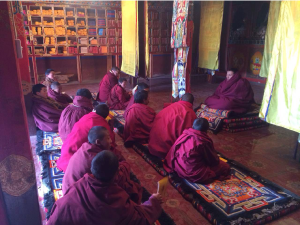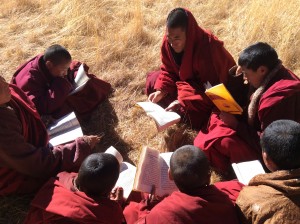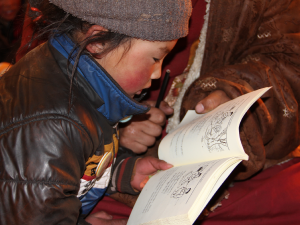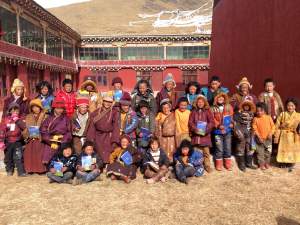Kilung Foundation Brings Education to Nomads
Written by: Cary Peterson

Kilung Monastery, in the snow of the Tibetan Himalayas.
Photos by: Pema Norbu.
Kilung Foundation, dedicated to bringing humanitarian and spiritual support to a key area of eastern Tibet, has been making significant progress in recent months.
The organization, based on Whidbey Island in Washington state, is in particular focused on the region of Dzuchuka, in the region of Tibet traditionally known as Kham.
The two key accomplishments are the launch of a second nine-year training program called a Shedra, in renovated facilities, and the start of an improved program at the Kilung Children’s school, in the shedra building.
To help provide livelihood for people in the region, Kilung Foundation is also helping launch a yogurt business. This will provide a market outlet for milk produced by nomads’ animals, and a source of livelihood for other nomads who have lost their herds.

Shedra class studying the Thirty-Seven Practices of the Way of the Bodhisattva.
These steps are important to the local people, because the fabric of life is changing rapidly in Dzachuka. Access to Tibetan education in Tibet is limited, and the ability of people to travel to attend Indian and Nepali educational institutions is being increasingly restricted. Meanwhile Chinese regulations managing pasturelands are curtailing traditional nomad culture, and making it hard for people to continue traditional lifestyles.
The Kilung Foundation has responded to these challenges with practical and creative solutions, to alleviate potentially devastating impacts on traditional Tibetan culture and lifestyle. These projects, which directly strengthen the threatened nomad and Tibetan Buddhist culture in Dzachuka, are supported by generous donations from people around the world, and more help is always needed.
The Kilung Foundation was founded in 1998 by His Eminence Kilung Jigme Rinpoche, a well-known Buddhist teacher and traditional lama.

Kilung Children’s School class.
Rinpoche was recognized as the fifth reincarnation of H. H. Jigme Ngostar Gyatso as a young boy, during China’s Cultural Revolution of the late 1960s. At a time when Buddhist practices were forbidden and dangerous in Tibet, Rinpoche was taught in secret in a yak hair tent, and lived the life of a nomad child traveling with the animals between the vast summer and winter pasturelands of Dzachuka, East Tibet (Kham).
As a teenager he completed a traditional three-year retreat, and then began his life’s work of restoring Kilung Monastery, the central monastery of his lineage, and also preserving the Tibetan spiritual traditions and nomad culture of his community.
Dating from 1770, Kilung Monastery had been a great center of learning and practice in the Longchen Nyingtik lineage. While much of the complex was destroyed during the Cultural Revolution the central temple survived, and the foundation and Rinpoche have been gradually restoring it.

A student studying at the Kilung school.
A key part of the monastery’s traditional work, the nine-year scholastic study program known as the shedra, also been gradually brought back to life.
In 2005, the Kilung Foundation first restored the Kilung Shedra building that had been destroyed during the Cultural Revolution, and restarted the intensive study of Tibetan Buddhist dialectics and spiritual philosophy that is essential for developing skilled and educated monastic teachers and practitioners.
The first nine-year program of the revitalized shedra program was very successful, but the building itself was severely damaged by leaks in its traditional earthen roof, which was unable to withstand the increased rainfall in the region.
So this November, after a six-month renovation of the building including a new roof, funded by the Kilung Foundation, a fresh group of 30 young monks began their nine-year training. They were led by the experienced and wise Khenpo Thubten Zangpo.
In his youth Khenpo Thubzang had made the perilous journey across the Himalayas to obtain monastic education and training in India and Nepal. When he completed his education, it was extremely difficult and hazardous to return to Tibet.
The Kilung Foundation worked for three years to help him get back to Dzachuka, and Khenpo Thubzang is now working tirelessly to provide monastic education at the Kilung Monastery, so that others do not have to leave their community and endure the hardships he did.

Shedra monks studying outside.
Also in November 2014, the Kilung Children’s School launched a new boarding school with 30 eager young boys from the local community, ages eight to 12. The Kilung Children’s School is housed in the newly renovated shedra building, and provides a strong Tibetan education as an alternative to no school, or a government school in the distant town.
Previously, many children from the region journeyed over the mountains to schools in India, as Khenpo Thubzang had. But with the Chinese authorities significantly restricting border crossings to make sure local children don’t leave, it is more important than ever to provide Tibetan education within Tibet.
For instance Sonam Wangchuk, eight years old, is the second youngest of seven children in his family, and the first in his family to go to school, at the Kilung Children’s School.
Like his older siblings Sonam will learn how to care for family animals, but he will also be learning how to read and write. With his education he will be better able to function in modern society and the local economy.
Because the children live at the monastery in the community of monks, it isn’t possible to have girls in this group. However, thanks to the generous sponsorship of Asian donors, 10 girls from the Kilung community are able to study at a well-known Tibetan girl’s school in Amdo.

A student learning to read.
A major goal for the Kilung Foundation is to provide the necessary financial support for the Shedra and the Kilung Children’s School. We are striving to raise enough to provide more than $5,500 per month to provide daily meals and lodging for the 60 earnest students (30 monks and 30 children). We also need to pay salaries to the dedicated teachers and support staff, and to provide needed educational materials.
The cost is less than $100 per student a month, but it still adds up! We are actively seeking benefactors and supporters to fund the ongoing costs of these two schools.
Another vital part of community life is the prayers and pujas that the Kilung monks perform. Now, through the Kilung Foundation website, people from all over the world can request prayers and pujas, and prayer flags, at the Kilung Monastery.
In 2008, the Kilung Monastery and community began a life-release farm to provide aid for those Tibetans suffering from the earthquake in Kyegundo. One can now request to save a goat, sheep or yak from imminent slaughter, or arrange to have a Kilung family care for an animal for its lifespan, and never send it to slaughter.
The wool, dung and milk products from these animals help to supply the monastery, shedra and Kilung Children’s School.

Kilung students after class.
Recently, with the Chinese government’s restriction of traditional pasture lands, more animals are being crowded onto less land. In many areas, the animals don’t have enough food to survive.
Nomad families are forced to give up their animals, but they rarely have the skills to make a living in an urban setting. As a way to preserve the fabric of the nomad culture, the Kilung Foundation is helping to launch a small yogurt business.
Ten families will be joining this business. Among these are Lhakpa Lhamo, her husband Konchok and their three children, who still have a herd of 50 yaks.
Lhamo’s son is enrolled in the Kilung Children’s School, and she and her family were featured in the movie “Crossing the Dzachu River.”
They, and other families still with animals, will each contribute five female yaks (dri). Families who have lost their animals will be responsible for caring for the dri and milking them. They will make yogurt from the fresh milk, and transport it to town to sell.
The profits will go to the families and to support the ongoing business. Many of the saved yaks will be supplying the new yogurt business. Kilung Foundation is working to raise $15,000 to buy a mini-truck and containers for this enterprise.
Besides the projects mentioned above, the Kilung Foundation also helps with the support of monks, nuns, and elderly people. The foundation is also raising funds to reinstall the ancient Kilung Mani Wall, which was destroyed 50 years ago, and whose stones have been painstakingly gathered back up again.
The vitality of the people, land, and animals of the nomad culture, the local economy and the Tibetan Buddhist spiritual tradition are all interconnected. Through compassionate and practical actions that benefit the whole community, the Kilung Foundation is working to preserve and restore these precious and threatened traditions.
To support the humanitarian, educational, and cultural initiatives of the Kilung Foundation, please visit our website, or email tibet@kilung.org.
